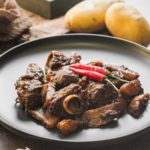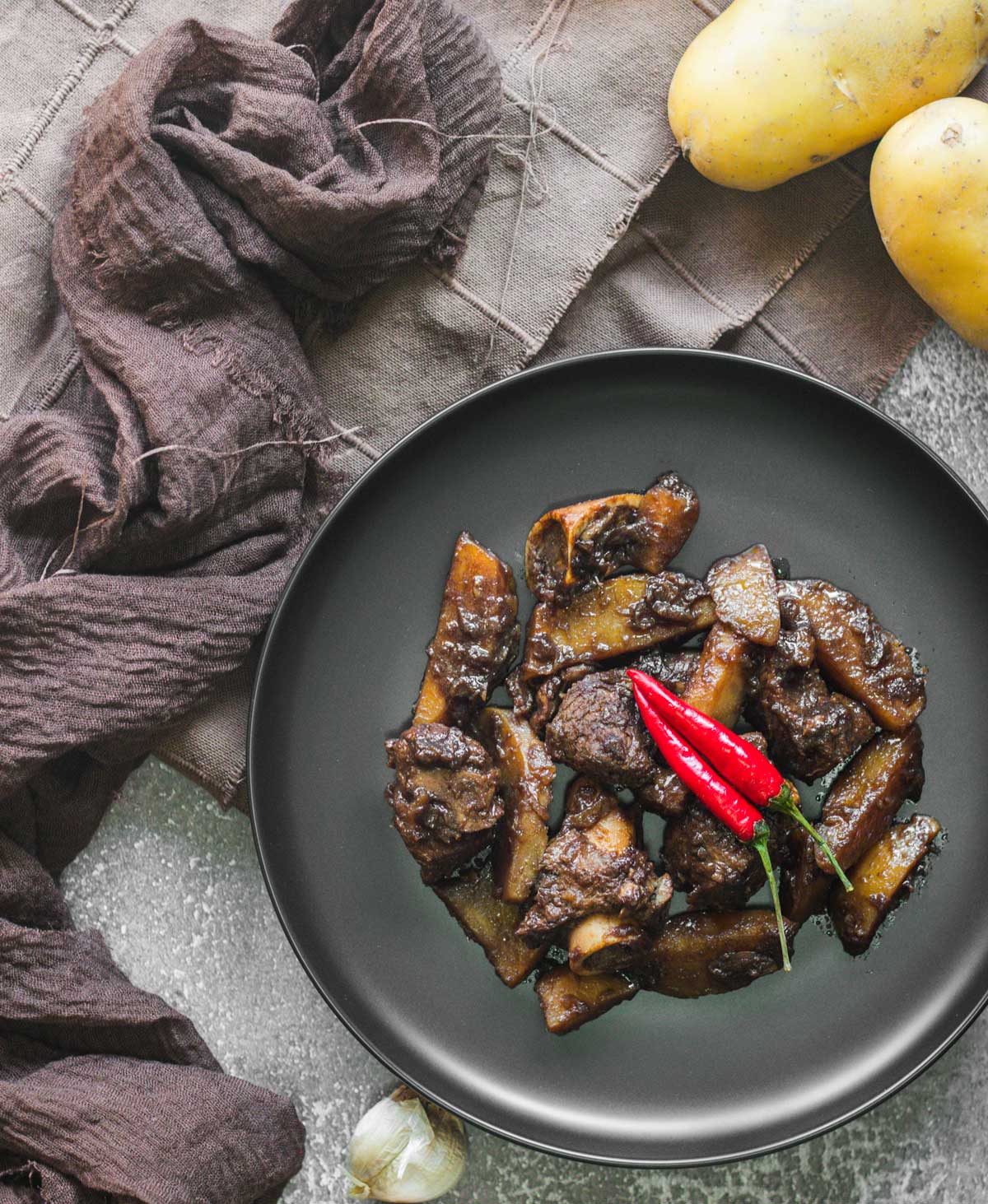Indonesians have something called bistik, literally a mangling of Dutch’s biefstuk or English’s beef steak. This is an example of European-influenced Indonesian dishes that came about during the 300 years of Dutch colonial rule in the country, and is one that I was particularly fond of, growing up.
Although the dish is inspired by the ‘beef steak’, in reality, Indonesian bistik doesn’t have to be made from beef at all. Instead, it now refers to a dish with a thick brown sauce that mimics steak sauce, with slices or chunks of meat in it. Beef is still often used, and it is known as bistik daging sapi (literally, cow-meat bistik). Or, sometimes it’s made from chicken, in which case it’s bistik ayam (chicken bistik).
(Incidentally, this isn’t unique to Indonesia. In Singapore, local Indian restaurants also serve something called bistik, but this is an entirely different dish that bears no resemblance to either the Indonesian or the European varieties.)
Growing up, I often had bistik daging kambing, or lamb bistik. Its concept is similar to Indonesian dishes like karang binanci embi, in which the meat is seared and simmered in a spice gravy, which is then reduced to form a thick sauce. The difference between bistik and dishes like karang binanci embi is that bistik tries to create a more “Western” taste by omitting Indonesian-ish ingredients like chillies.
Preparing bistik
There are many ways to prepare bistik, and no two recipes are the same. For this recipe, I’ve tried to reduce the cooking time by starting to simmer the meat first, before preparing the other ingredients. While the meat simmers in the pot, I begin to peel and slice the onions, garlic, etc. Ideally, you wouldn’t do that – you’d prepare all the ingredients first, then saute the onions along with the dry whole spices, add the shallots, garlic, ginger. Then you’d sear the meat, add the soy sauce and water.
Print
Bistik Daging Kambing: Lamb ‘Steak’, or Soy Sauce Lamb
- Prep Time: 10 minutes
- Cook Time: 2 hours
- Total Time: 2 hours 10 minutes
- Yield: 3 1x
- Category: Beef & Lamb
- Method: Braising
- Cuisine: Indonesian
- Diet: Halal
Description
Bistik is an Indonesian adaptation of ‘beef steak’, and is made by braising meat in a soy sauce gravy that’s later reduced to form a thick sauce. It can be made with any meat, and in this case, we’ve used lamb.
Ingredients
- 350g boneless lamb pieces
- 750 ml water
- 7 cloves
- 1” cinnamon stick
- 7 cardamom pods
- 1 bay leaf
- 2 tbsp dark or sweet soy sauce
- 3 medium-sized red onions, peeled and sliced
- 4 cloves garlic, peeled and chopped
- 5 shallots, peeled and sliced
- 1” ginger, peeled and sliced
- 3 small potatoes, sliced
- ½ tsp black pepper powder.
- 2 tsp ghee
- 3 tbsp vegetable oil
- Salt to taste
Instructions
- Fill a large boiling pot with the 750ml water. Add the cloves, cinnamon stick, cardamom pods, and bay leaf. Bring to a boil.
- Add the lamb and some salt. Lower the heat to a simmer.
- Meanwhile, in a wok or a large pan, heat the vegetable oil over low heat. Add the ghee.
- Add the sliced onions. Sauté on low heat until brown and caramelized, about 20 minutes.
- Add the shallots until they soften. Then, add the ginger and garlic. Sauté until fragrant, about 3 minutes.
- Add the dark or sweet soy sauce, and black pepper powder.
- Pour all the contents of the boiling pot of meat into the wok or frying pan, and continue simmering for about 1 hour, or until the meat is tender.
- Then, add the potatoes until they soften.
- Increase the heat to reduce the gravy to a thick sauce.
- Turn off the heat and serve.
Notes
- It’s best to use thick slices of meat for this dish. I used chunks instead because they weren’t available at the supermarket.
- To remove scum from the lamb, I usually soak the meat in cold water first and rinse it. Then, I boil it in a bot for a few minutes until I see the scum floating on the top. I then strain it and set the meat aside.
- Kicap manis, or Indonesian sweet soy sauce, is usually used for the dish. But I don’t like sweet food, so I use dark soy sauce instead – which is why the meat here looks so black. Using kicap manis will yield a rich dark brown sauce.
Keywords: Non-spicy, Kicap manis, cardamom, cinnamon





